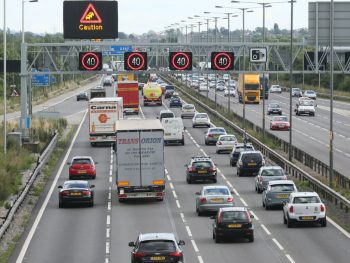Fleet concerns over smart motorways revealed in new Licence Check research
More than 80% of fleets feel smart motorways are unsafe or could be improved, according to new research.

Critics say the emergency refuge areas on smart motorways are too far apart and that anyone breaking down or being involved in an accident has little chance in reaching them unaided
A poll of customers by risk management specialist Licence Check found some 56% of respondents said they thought smart motorways were not safe, a further 28% said they thought they could be improved and just 17% thought that they were safe.
The results chime with a new Transport Select Committee report which concluded there was not enough safety and economic data to justify continuing with the Government’s plans to roll out an additional 300 miles of all-lane running motorway by 2025.
The report said government plans to remove the hard shoulder from all future smart motorways were premature and that it should pause the roll-out of new all-lane running schemes until five years of safety and economic data was available for every scheme introduced before 2020.
This comes after a number of inquests this year into smart motorway deaths, where fatalities have been determined to be a direct consequence of the hard shoulder being replaced by an active lane.
Critics say the emergency refuge areas (ERAs) on smart motorways are inconveniently spaced, typically 1.5 miles apart, and that anyone breaking down or being involved in an accident has little chance in reaching them unaided. A BBC Panorama investigation earlier this year found some 38 motorists had been killed on smart motorways in the last five years.
Meanwhile, records show that there has been a 20-fold increase in the number of near-misses – an incident with the potential to cause injury or ill health – on just one section of the M25, since the hard shoulder was removed.
A number of motoring organisations have expressed concerns about smart motorways, including the AA, RAC and Brake and now Licence Check has lent its support to calls for further action on addressing safety.
Terry Hiles, general manager at Licence Check, said that a review by the Department for Transport as a result of growing safety concerns had made a series of recommendations regarding smart motorways, but that they were some way off from being implemented.
“These include converting Dynamic Hard Shoulder motorways to all lane running, rather than having a hard shoulder which can be switched on and off during peak times, as this was deemed too confusing for motorists.
“They also advocated the more widespread deployment of stranded vehicle technology and increased monitoring to identify stricken vehicles more quickly and close affected lanes faster.
“And they also suggested relocating the ERAs so that they are no more than ¾ to 1.0 miles apart. However, these recommendations are not set to come in for another three years and until then the existing concerns remain,” he explained.
Smart motorway breakdown advice
Hiles has also issued advice for drivers unlucky enough to break down or be involved in an incident on a smart motorway.
- Where possible, you should attempt to use an ERA, which is marked with a large blue sign featuring an orange SOS telephone symbol.
- Arrows will direct you into an indicated area, where you should stop and switch on your hazard warning lights. Occupants should then exit the vehicle from the passenger side and stand behind the crash barrier, while the driver should phone Highways England who will provide further instructions.
- If you are unable to reach the nearest ERA, you should try to move on to the verge if there is no safety barrier and it is safe to do so. In all cases, switch on your hazard warning lights.
- If you are forced to stop in the nearside lane, exit your vehicle via the nearside and wait behind the safety barrier, if there is one.
- If it is not possible to get to the nearside lane or exit your vehicle safely, then you should stay in your vehicle with your seat belt on and dial ‘999’ if you have access to a mobile phone.
- When the relevant highways authority becomes aware of a breakdown or an incident on they should switch on a red cross sign on the gantries above the lane you’re in to stop traffic from entering it.”












